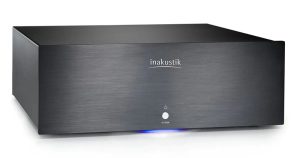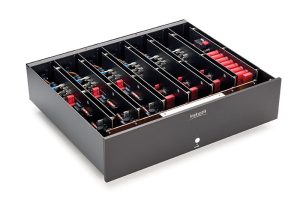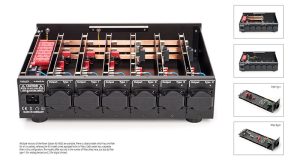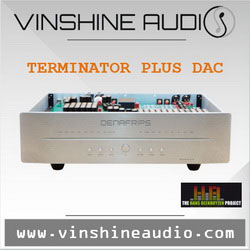Inakustik Power Station AC-4500 AC conditioner by Clement Perry

 I should have never accepted the offer to hear the Inakustik Power Station AC-4500 conditioner. Serendipity struck when World Wide Wholesales owner Robert Neill offered me a review sample after discussing other high-end audio products he imports. For the past three-plus years, I have happily lived with the Puritan Audio Labs 156, which outperformed a very popular AC conditioner four times its $2400 asking price (the accompanying AC cord was $4k alone!). Heck, my Puritan 156 can still be the best I’ve heard, that is, if I can somehow find a way to un-hear what I just experienced after three months with the Inakustik Power Station AC-4500.
I should have never accepted the offer to hear the Inakustik Power Station AC-4500 conditioner. Serendipity struck when World Wide Wholesales owner Robert Neill offered me a review sample after discussing other high-end audio products he imports. For the past three-plus years, I have happily lived with the Puritan Audio Labs 156, which outperformed a very popular AC conditioner four times its $2400 asking price (the accompanying AC cord was $4k alone!). Heck, my Puritan 156 can still be the best I’ve heard, that is, if I can somehow find a way to un-hear what I just experienced after three months with the Inakustik Power Station AC-4500.

 Located along the southern tip of Germany, Inakustiks has been quietly building its cables and audio accessories since 1977. Known for its attractively branded cable line, the company has been slowly making waves here in the USA. In the wake of the COVID-19 Pandemic, many companies called it quits. The folks at Inakustik took the opportunity to focus on their brand and, as a result, gained even greater momentum. It was in mid-2022 that the company decided to design its first AC conditioner from the ground up. That product is the Inakustik Power Station-4500, which is here under review.
Located along the southern tip of Germany, Inakustiks has been quietly building its cables and audio accessories since 1977. Known for its attractively branded cable line, the company has been slowly making waves here in the USA. In the wake of the COVID-19 Pandemic, many companies called it quits. The folks at Inakustik took the opportunity to focus on their brand and, as a result, gained even greater momentum. It was in mid-2022 that the company decided to design its first AC conditioner from the ground up. That product is the Inakustik Power Station-4500, which is here under review.
The Inakustik Power Station AC-4500 (herein AC-4500) is imported into the USA by Robert Neill and his Canadian-based World Wide Distributors. The AC-4500 comprises six Schuko 15A outlets divided by two independent-type filter banks. Type I, designed entirely in-house, uses a series filter circuit and is suitable for analog devices, i.e., amplifiers, preamps, turntables, phonostages, tape decks, etc. The Type II filter employs a parallel circuit best suited for digital streamers, DACs, CD players, and Class D amplification.



Taking the hood off, the AC-4500 sports a clean and modernized internal appearance by employing independent vertical circuit boards for each outlet. The AC-4500 power station purportedly suppresses all unwanted AC and DC interference from the electrical grid, including distortions created by analog and digital devices, without restricting current flow. The AC 4500 is said to protect our beloved components from extreme voltage peaks through its over-voltage protection circuit.
Additionally, the massive chassis reduces mechanical vibrations of the filter components caused by the 60-Hz grid frequency. The technical design of this product features an elegant front panel made of brushed aluminum. The housing interior is designed so that the six high-quality power sockets are optimally shielded from one another. Another design highlight is the solid copper busbars and special solderless high-current connectors that ensure that loop resistance is extremely low, which provides outstanding current delivery capacity.
 Housed in a solid metal casing made of 2mm thick galvanized steel, the AC-4500 has a solid feel and build. The face plate is made of elegant-looking brushed aluminum with only a power On/Off LED at its center. Despite its streamlined layout and only six outlets, the AC-4500 weighs about 35 lbs. The 4500 has half the outlet capacity as my reference Puritan Audio Labs 1512 (which I upgraded to after a short spell with the 156). This made life a tad more difficult since I had to keep my Brinkmann Balance turntable’s vacuum-tubed motor drive and three Frank Acoustics UB-2500 AC Enhancers plugged into the 1512. This had little, if no, consequence on the sound since I could plug both Behold BPA-768 amplifiers and the Behold APU-768 preamp into the three Type I (analog) outlets. The Laufer Teknik Memory Player 64 music server, Chord M-Scaler (along with its Sean Jacobs linear power supply), was plugged directly into the AC-4500’s Type II (digital) outlets.
Housed in a solid metal casing made of 2mm thick galvanized steel, the AC-4500 has a solid feel and build. The face plate is made of elegant-looking brushed aluminum with only a power On/Off LED at its center. Despite its streamlined layout and only six outlets, the AC-4500 weighs about 35 lbs. The 4500 has half the outlet capacity as my reference Puritan Audio Labs 1512 (which I upgraded to after a short spell with the 156). This made life a tad more difficult since I had to keep my Brinkmann Balance turntable’s vacuum-tubed motor drive and three Frank Acoustics UB-2500 AC Enhancers plugged into the 1512. This had little, if no, consequence on the sound since I could plug both Behold BPA-768 amplifiers and the Behold APU-768 preamp into the three Type I (analog) outlets. The Laufer Teknik Memory Player 64 music server, Chord M-Scaler (along with its Sean Jacobs linear power supply), was plugged directly into the AC-4500’s Type II (digital) outlets.
Listening impressions
Initially, the music was a tad more distant and further away with the AC-4500 than with the 1512. The music appeared more relaxed and laid back regardless of the volume setting. This took me some time to adjust since I hardly detected the wrap-around, surround-sound effect the 1512 so quickly provided. Through the AC-4500, the bass seemed slightly lighter, somewhat tighter, and reserved. One thing is sure: these two AC titans do not sound the same. It took some time, but I noticed more and more sonic differences between the two the more music I played. As mentioned, the 4500s bass felt lighter, tighter, and distant, but it also possessed more grip and dynamic snap, crackle, and pop.  Ndegeocello’s Papillon, from “The Spirit Music Jamia: Dance of the Infidel,” is quite a dynamic kaleidoscope of sounds and synthesizers that grabbed my attention years ago. Through the AC-4500, the bass wasn’t as upfront as through the 1512, yet it was more developed and authoritative, as if it had gained more momentum from its relaxed footprint. Adding distance and space among the musicians gave this song a dynamic energy and prowess I’d not noticed previously. I was taken aback by what I initially felt was lighter bass, which has somehow morphed into a faster, more tuneful, and more impactful bass with each song. The bass also became more accessible, giving it greater musical appeal. So much so that I found it difficult to leave the room.
Ndegeocello’s Papillon, from “The Spirit Music Jamia: Dance of the Infidel,” is quite a dynamic kaleidoscope of sounds and synthesizers that grabbed my attention years ago. Through the AC-4500, the bass wasn’t as upfront as through the 1512, yet it was more developed and authoritative, as if it had gained more momentum from its relaxed footprint. Adding distance and space among the musicians gave this song a dynamic energy and prowess I’d not noticed previously. I was taken aback by what I initially felt was lighter bass, which has somehow morphed into a faster, more tuneful, and more impactful bass with each song. The bass also became more accessible, giving it greater musical appeal. So much so that I found it difficult to leave the room.
What ultimately was confirmed through hundreds of hours of listening is that the bass of the Inakustik 4500 is faster, tighter, and more musically engaging than my beloved Puritan 1512. This led to an improved sense of soundstage that was different from surround sound effect I admired in the 1512. The soundstage created by the AC-4500 came from a distant space that was overall quiet, focused, and transparent. The reduction of bass bulge offered greater clarity to the music. To accuse my mighty Puritan of muddling the lower bass region would be sacrilege before introducing the AC-4500 into my system. Yet, having these two excellent AC conditioners side by side, an unwanted thickness emerged in the bass region produced by the 1512. The downside of the AC-4500 was that the wrap-around effect I so adored in 1512 wasn’t as evident in the AC-4500.
The Air Up There
 After another seven days of burn-in, I noticed the AC-4500 impacted the air surrounding high frequencies. Cymbals gained more delicacy, sparkle, and breadth while the decay lingered. I noticed the sonic excellence in the low end in the first week, and now the extension of high-frequencies being noticed. Was the 1512 rolled off? This noted improvement in delicacy, sparkle, and breadth aided in the increased realism, plus the high-frequency extension invited a new sense of freedom to the music. When I hear digital playback this alive, and expressive, it is great news especially when it comes devoid of digital hardness. Let me reiterate that, in that first week, with less than 100 hours of burn-in achieved, the AC-4500 tilted the balance toward a brighter and leaner presentation. In week number two, or well over 300 hours of round-the-clock burn-in, the light-hearted bass started putting on some weight and muscle. I invited a few close friends and audiophiles over for a listen after the AC-4500 had achieved over 400 hours on it. A few of them also own the mighty Puritan 156 and know firsthand its sonic capabilities.
After another seven days of burn-in, I noticed the AC-4500 impacted the air surrounding high frequencies. Cymbals gained more delicacy, sparkle, and breadth while the decay lingered. I noticed the sonic excellence in the low end in the first week, and now the extension of high-frequencies being noticed. Was the 1512 rolled off? This noted improvement in delicacy, sparkle, and breadth aided in the increased realism, plus the high-frequency extension invited a new sense of freedom to the music. When I hear digital playback this alive, and expressive, it is great news especially when it comes devoid of digital hardness. Let me reiterate that, in that first week, with less than 100 hours of burn-in achieved, the AC-4500 tilted the balance toward a brighter and leaner presentation. In week number two, or well over 300 hours of round-the-clock burn-in, the light-hearted bass started putting on some weight and muscle. I invited a few close friends and audiophiles over for a listen after the AC-4500 had achieved over 400 hours on it. A few of them also own the mighty Puritan 156 and know firsthand its sonic capabilities.
 Upon first blush, they, too, sensed this new level of clarity, especially in the bass – without being aware that I had changed anything. Greg Voth was rather shocked at what he thought was an added sense of see-through dimensionality that he felt improved the soundstage considerably. Greg kept pointing to how far he could see instruments layered front to back that had been partially hidden. Ed Van Winkle insisted the sound had taken a step backward after noticing the depletion of low-frequency weight and prowess. Ed stated, “The sound has shifted its balance to being more tilted towards the higher frequencies. Of course, I didn’t argue because that was also my initial impression. When I played jazz guitarist Steve Khan’s wonderfully recorded The Journey Home from his “Patchwork” CD, Ed began to figure out what had me so enthralled by the improved low-end clarity. “Yeah, it’s got a ton of rhythmic drive and punch, but still doesn’t have the weight I’ve enjoyed so much in the Puritan.” The shift, in Ed’s opinion, slowly changed over within the next hour as we went through our favorite songs. Ed slowly began to recognize what was happening and what was so admirable about the Inakustik 4500. “The sound is cleaner, faster, remarkably agile, and has a fantastic top-end,” said Ed.
Upon first blush, they, too, sensed this new level of clarity, especially in the bass – without being aware that I had changed anything. Greg Voth was rather shocked at what he thought was an added sense of see-through dimensionality that he felt improved the soundstage considerably. Greg kept pointing to how far he could see instruments layered front to back that had been partially hidden. Ed Van Winkle insisted the sound had taken a step backward after noticing the depletion of low-frequency weight and prowess. Ed stated, “The sound has shifted its balance to being more tilted towards the higher frequencies. Of course, I didn’t argue because that was also my initial impression. When I played jazz guitarist Steve Khan’s wonderfully recorded The Journey Home from his “Patchwork” CD, Ed began to figure out what had me so enthralled by the improved low-end clarity. “Yeah, it’s got a ton of rhythmic drive and punch, but still doesn’t have the weight I’ve enjoyed so much in the Puritan.” The shift, in Ed’s opinion, slowly changed over within the next hour as we went through our favorite songs. Ed slowly began to recognize what was happening and what was so admirable about the Inakustik 4500. “The sound is cleaner, faster, remarkably agile, and has a fantastic top-end,” said Ed.
 After over a month of burn-in, I invited my old friends and legendary jazz drummer Billy Drummond and Grammy Award-winning jazz bassist John Hebert for a session without mentioning anything. I wanted to see if the system sounded unchanged, better or worse to them. Of course, Billy Drummond already knew what I was doing because he and Ed Van Winkle are best friends, and Ed always shares his experiences regarding what’s happening here. We’re all longtime friends, neighbors, and audio hobbyists. Despite what Billy heard from Ed, within just a few minutes of hearing Shirley Horn’s You Won’t Forget Me, he looked pleasantly surprised. I love Billy’s honesty and the way in digs into a tune. He gets into a particular position once in the sweet spot, closes both eyes, and starts getting into it. What did he get into? I’m not sure since he’s the musician, and I am the ultimate fan. Which is why I admire the way he goes in. After a few minutes, he returns and gives that look of appreciation. “Damn P, what did you do? I hear so much going on in this song that I never noticed. You’re telling me all you did was change the AC line conditioner? Damnnn!” Of course, I nod and think, wow, these guys can hear it, too. John Hebert, the audio neophyte who only recently got into the hobby compliments of Billy Drummond and myself, took the sweet spot, looked at me incredulously, and stated, “You mean to tell me that this is the result of you swapping out an extension cord?” I smile and say, “Something a little more sophisticated than an extension cord, but yeah.”
After over a month of burn-in, I invited my old friends and legendary jazz drummer Billy Drummond and Grammy Award-winning jazz bassist John Hebert for a session without mentioning anything. I wanted to see if the system sounded unchanged, better or worse to them. Of course, Billy Drummond already knew what I was doing because he and Ed Van Winkle are best friends, and Ed always shares his experiences regarding what’s happening here. We’re all longtime friends, neighbors, and audio hobbyists. Despite what Billy heard from Ed, within just a few minutes of hearing Shirley Horn’s You Won’t Forget Me, he looked pleasantly surprised. I love Billy’s honesty and the way in digs into a tune. He gets into a particular position once in the sweet spot, closes both eyes, and starts getting into it. What did he get into? I’m not sure since he’s the musician, and I am the ultimate fan. Which is why I admire the way he goes in. After a few minutes, he returns and gives that look of appreciation. “Damn P, what did you do? I hear so much going on in this song that I never noticed. You’re telling me all you did was change the AC line conditioner? Damnnn!” Of course, I nod and think, wow, these guys can hear it, too. John Hebert, the audio neophyte who only recently got into the hobby compliments of Billy Drummond and myself, took the sweet spot, looked at me incredulously, and stated, “You mean to tell me that this is the result of you swapping out an extension cord?” I smile and say, “Something a little more sophisticated than an extension cord, but yeah.”
In conclusion
There will be tradeoffs whenever you compare two great-sounding products; moreover, different outcomes can occur in different systems. However, in my system, what I discovered via the installation of the Inakustik Power Station 4500 coincides with the quality of musical enjoyment I’ve always hoped for but wasn’t sure existed at this asking price. In all fairness, I was so satisfied with the Puritan 1512 over the past three-plus years that I had no intention of changing it in the foreseeable future. Based solely on performance, the Inakustik Power Station AC-4500 ($5800) is the logical upgrade. Yes, it doubles the cost of the Puritan 156 ($2400) and is $1500 more than the twelve-outlet Puritan 1512 ($4300). The asking price of the Inakustic Power Station AC-4500 shouldn’t scare potential buyers away if they’ve been looking for a successor to the mighty Puritan and were waiting for the right time. Knowing how expensive our beloved hobby has become, I consider the Inakustik Power Station AC-4500 a steal for $5800, especially considering how it pushed my system beyond what I thought was sonically possible at its asking price. I highly recommend the Inakustik Power Station AC-4500 and nominated it as my Publisher’s Choice Most Wanted Component for 2023!


Specifications
Price: $5800
Outputs: 6
Supply voltage: 100-250V AC / 50-60Hz
Operating current (max.): 15 A
Input power (max.): 1,875 VA (120 VAC, 15 A)
Dimensions: 450 mm × 386 mm × 122 mm (W × D × H)
Weight: 33 lbs
Power inlet: IEC C-20 socket
USA Importer
Robert Neill
Worldwide Wholesales
Website: www.worldwidewholesales.com/
5 thoughts on "Inakustik Power Station AC-4500 AC conditioner by Clement Perry"
Leave a Reply
Stereo Times Masthead
Publisher/Founder
Clement Perry
Editor
Dave Thomas
Senior Editors
Frank Alles, Mike Girardi, Russell Lichter, Terry London, Moreno Mitchell, Paul Szabady, Bill Wells, Mike Wright, and Stephen Yan,
Current Contributors
David Abramson, Tim Barrall, Dave Allison, Ron Cook, Lewis Dardick, John Hoffman, Dan Secula, Don Shaulis, Greg Simmons, Eric Teh, Greg Voth, Richard Willie, Ed Van Winkle, Rob Dockery, Richard Doron, and Daveed Turek
Site Management Clement Perry
Ad Designer: Martin Perry






Hi there,
Obviously you are taken by the Inakustik Power Station AC-4500. But as it is very expensive, one strives to find alternative options… So how would you compare this with grounding systems like the types of Akiko Triple AC Enhancer?
Hi Jugi,
Not sure I would sonically compare a grounding system to something like an AC conditioner that performs like the Inakustik. I have always found AC conditioners to be more effective. Secondly, I have some success with ground conditioners but decided they subtracted life out of the high frequencies. The Inakustik does the opposite which is why it is so valuable.
Thanks! Was kind of suspecting that, of course…
I don’t agree with your conclusion about the grounding units.
I’m using Akiko Loud Speaker units and they are making miracles here!!
… and I’m Puritan distributor here ….and Akiko 🙂
Hello Jacob,
I wholeheartedly agree with your assessments…prior to installing the Inakustic 4500. If and when you have the opportunity to hear that it in your system. Then tell me if you experience what I did. I found it hard to believe what I felt as a subtle constriction in the high-frequencies produced by the AC ground conditioners (including the Akiko). Heck, even if you don’t experience what I did with the Inakustic doesn’t make me, or you, wrong. Different strokes for different folks.
Clement Perry